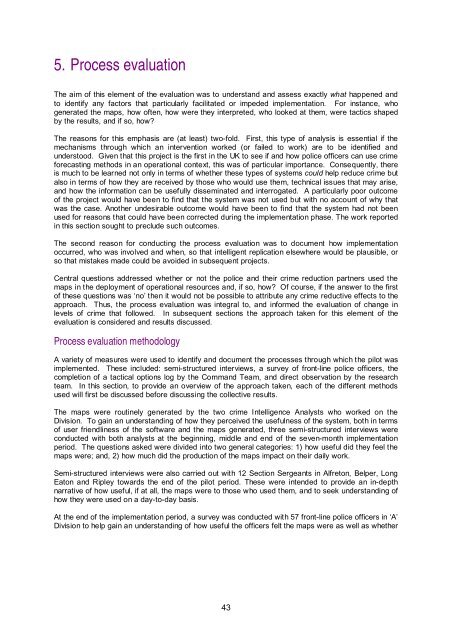Prospective crime mapping in operational context Final report
Prospective crime mapping in operational context Final report
Prospective crime mapping in operational context Final report
- No tags were found...
Create successful ePaper yourself
Turn your PDF publications into a flip-book with our unique Google optimized e-Paper software.
5. Process evaluationThe aim of this element of the evaluation was to understand and assess exactly what happened andto identify any factors that particularly facilitated or impeded implementation. For <strong>in</strong>stance, whogenerated the maps, how often, how were they <strong>in</strong>terpreted, who looked at them, were tactics shapedby the results, and if so, how?The reasons for this emphasis are (at least) two-fold. First, this type of analysis is essential if themechanisms through which an <strong>in</strong>tervention worked (or failed to work) are to be identified andunderstood. Given that this project is the first <strong>in</strong> the UK to see if and how police officers can use <strong>crime</strong>forecast<strong>in</strong>g methods <strong>in</strong> an <strong>operational</strong> <strong>context</strong>, this was of particular importance. Consequently, thereis much to be learned not only <strong>in</strong> terms of whether these types of systems could help reduce <strong>crime</strong> butalso <strong>in</strong> terms of how they are received by those who would use them, technical issues that may arise,and how the <strong>in</strong>formation can be usefully dissem<strong>in</strong>ated and <strong>in</strong>terrogated. A particularly poor outcomeof the project would have been to f<strong>in</strong>d that the system was not used but with no account of why thatwas the case. Another undesirable outcome would have been to f<strong>in</strong>d that the system had not beenused for reasons that could have been corrected dur<strong>in</strong>g the implementation phase. The work <strong>report</strong>ed<strong>in</strong> this section sought to preclude such outcomes.The second reason for conduct<strong>in</strong>g the process evaluation was to document how implementationoccurred, who was <strong>in</strong>volved and when, so that <strong>in</strong>telligent replication elsewhere would be plausible, orso that mistakes made could be avoided <strong>in</strong> subsequent projects.Central questions addressed whether or not the police and their <strong>crime</strong> reduction partners used themaps <strong>in</strong> the deployment of <strong>operational</strong> resources and, if so, how? Of course, if the answer to the firstof these questions was ‘no’ then it would not be possible to attribute any <strong>crime</strong> reductive effects to theapproach. Thus, the process evaluation was <strong>in</strong>tegral to, and <strong>in</strong>formed the evaluation of change <strong>in</strong>levels of <strong>crime</strong> that followed. In subsequent sections the approach taken for this element of theevaluation is considered and results discussed.Process evaluation methodologyA variety of measures were used to identify and document the processes through which the pilot wasimplemented. These <strong>in</strong>cluded: semi-structured <strong>in</strong>terviews, a survey of front-l<strong>in</strong>e police officers, thecompletion of a tactical options log by the Command Team, and direct observation by the researchteam. In this section, to provide an overview of the approach taken, each of the different methodsused will first be discussed before discuss<strong>in</strong>g the collective results.The maps were rout<strong>in</strong>ely generated by the two <strong>crime</strong> Intelligence Analysts who worked on theDivision. To ga<strong>in</strong> an understand<strong>in</strong>g of how they perceived the usefulness of the system, both <strong>in</strong> termsof user friendl<strong>in</strong>ess of the software and the maps generated, three semi-structured <strong>in</strong>terviews wereconducted with both analysts at the beg<strong>in</strong>n<strong>in</strong>g, middle and end of the seven-month implementationperiod. The questions asked were divided <strong>in</strong>to two general categories: 1) how useful did they feel themaps were; and, 2) how much did the production of the maps impact on their daily work.Semi-structured <strong>in</strong>terviews were also carried out with 12 Section Sergeants <strong>in</strong> Alfreton, Belper, LongEaton and Ripley towards the end of the pilot period. These were <strong>in</strong>tended to provide an <strong>in</strong>-depthnarrative of how useful, if at all, the maps were to those who used them, and to seek understand<strong>in</strong>g ofhow they were used on a day-to-day basis.At the end of the implementation period, a survey was conducted with 57 front-l<strong>in</strong>e police officers <strong>in</strong> ‘A’Division to help ga<strong>in</strong> an understand<strong>in</strong>g of how useful the officers felt the maps were as well as whether43
















